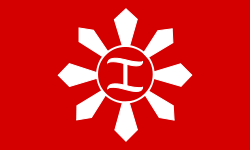- Banderas de la Revolución Filipina
-
Banderas de la Revolución Filipina
Durante la Revolución Filipina, se utilizaron varias banderas por parte de la sociedad secreta Katipunan y sus facciones, y más tarde, después de que el Katipunan se hubiera disuelto, las utilizaron el Ejército de Filipinas y su gobierno civil.
Otras banderas eran los estandartes personales de batalla de los diferentes comandantes de la zona militar operantes alrededor de Manila.
Las banderas mostradas en el presente artículo son las reconocidas oficialmente durante la Celebración Centenaria Filipina en 1998. Estas banderas con erróneamente incluidas en la "evolución de la bandera filipina"; son correctamente denominadas "banderas de la Revolución". Mientras muchos de los símbolos de las banderas están inspirados en la bandera nacional, no hay relación directa alguna.
Contenido
Banderas del Katipunan
Con el establecimiento del Katipunan, Andrés Bonifacio pidió a su mujer, Gregoria de Jesus, que creara una bandera para la sociedad. Ella diseñó una simple bandera roja con el acrónimo de la sociedad, KKK en blanco y colocado horizontalmente en el centro. Ésta fue la primera bandera oficial de la sociedad.
Algunos miembros del Katipunan utilizaron otras variantes. Una variante tiene las tres kas colocadas en formas de triángulo. Algunos otros utilizaron una bandera roja con una sola K.
When the revolution heated up, the Magdiwang faction of the Katipunan, which operated in Cavite under Gen. Mariano Alvarez, adopted a flag consisting of a red banner with white sun, at the center of which is a white baybayin (the ancient Tagalog script) letter ka. The sun initially had an indefinite number of rays and was later standardized to eight rays, to represent the eight provinces that Spain first placed under martial law (Manila, Cavite, Laguna, Batangas, Bulacan, Pampanga, Bataan, and Nueva Ecija). This eight-rayed sun was later used in the national flag of the Philippines. The flag is actually incorrectly placed on this page. It is flipped horizontally.
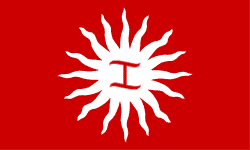
The Magdalo faction of the Katipunan, which also operated in Cavite under Gen. Emilio Aguinaldo, used a flag similar to the Magdiwang faction's. It features a white sun with a red baybayin letter ka.
This emblem has recently been revived by a breakaway faction of army officers calling themselves Bagong Katipuneros,[1] but labeled the Magdalo Group by the press. These officers mutinied against the government of Gloria Macapagal-Arroyo at the behest of Senator Gregorio Honasan and once again led by Senator Antonio Trillanes IV(see Oakwood mutiny and Manila Peninsula mutiny).
Personal flags
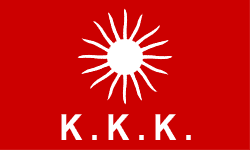
Andres Bonifacio, the Supremo of the Katipunan, had a personal flag which depicts a white sun with an indefinite number of rays on a field of red. Below the sun are three white Ks arranged horizontally. This flag was first unveiled on August 23, 1896 during the Cry of Pugadlawin where the assembled Katipuneros tore their Battle of San Juan del Monte on August 30, 1896, the first major battle of the Philippine Revolution.

General Mariano Llanera who fought in the provinces of Bulacan, Tarlac, Pampanga, and Nueva Ecija used a black flag with a white K on the left and a white skull-and-bones on the right. Bonifacio referred to the flag as Bungo ni Llanera or Llanera's Skull.
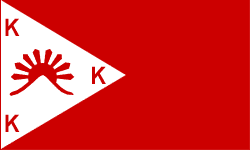
General Pio del Pilar, the hero of Makati, used a red banner which has a white equilateral triangle on the mast with a K at each corner. At the center of the triangle was a mountain with the sun rising behind it. The flag was called Bandila ng Matagumpay (Flag Of the Triumphants) and was first used on July 11, 1895. The flag was also one of the first to depict an eight-rayed sun.
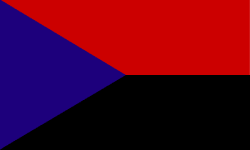
General Gregorio del Pilar, referred to as ang batang General ("the young General") for his youth, used a tricolor banner with a blue triangle at the mast and a red stripe at the top of the flag and a black stripe at the bottom. Del Pilar patterned his flag after that of Cuba's, which then was also revolting against Spain.
First Official Flag
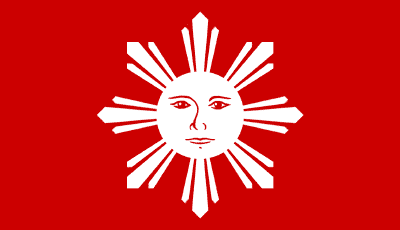
At the Naic Assembly of March 17, 1897, the Katipunan military leaders decided to adopt a flag with a new design. This new flag was red and depicted a white sun with eight rays and a face. This flag became the first official flag of the Filipinos. The flag was used for less than a year because the Filipinos signed a truce with Spanish authorities on December 14 to 15, 1897. References
- ↑ Laurel, Herman T. «Small setback...», The Daily Tribune, 2006-02-22. Consultado el 2007-08-10.
- “The Evolution of the Philippine Flag.” MSC's Philippine Centennial Celebration Website.
- “History of the Philippine Flag.” National Commission for Culture and the Arts.
- “Philippines - Historical Flags.” Flags of the World.
Categorías: Banderas históricas | Historia de Filipinas
Wikimedia foundation. 2010.


